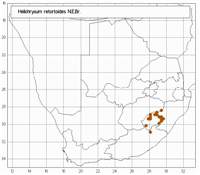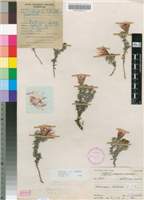Origin of name:
Resembling H. retortum
Diagnostic characters:
Large solitary headsWhite/pink bracts, outer golden-brown to reddishCompact plantSmall leaves, densely spaced
Description:
Diffusely branched perennial herb or subshrub, main stems prostrate, rooting, becoming thick and woody with age, flowering stems erect to c. 200 mm, uniformly and closely leafy. Leaves up to c. 10 x 3 mm, elliptic-oblong or subspathulate, upper surface with smooth sericeous 'tissue-paper' indumentum, green drying silvery grey, lower closely white-felted. Heads heterogamous, campanulate, c. 20 mm long, 30 mm across the fully radiating bracts, sessile, solitary at the tips of the branches. Involucral bracts in c. 9 series, closely imbricate, outer much shorter and broader than inner, glossy brown with a crimson tinge, inner much exceeding the flowers, white or tinged rose-pink to crimson, opaque. Receptacle shallowly honeycombed. Flowers 50�68, 3�8 female, 47�56 homogamous. Achenes 1.75 mm long, ellipsoid, glabrous or with a few duplex hairs. Pappus bristles many, equaling corolla, tips subplumose, shaft scabrid, bases cohering by patent cilia with some fusion as well.
Flowers from September to December.
Distribution:
On the high Drakensberg and the high Lesotho mountains between c. 2 200 and 3 350 m. Forms diffuse mats on steep broken turf slopes or among boulders in stony grassland, or in the crevices of rock sheets; dominant in places on the summit plateau.
Grassland Biome.
Taxonomy:
Literature:
Helichrysum retortoides N.E. Br. in Kew Bull. 1906: 164 (1906); Hilliard, Compositae in Natal 223 (1977).
Type:
KwaZulu-Natal, on the slopes of the Drakensberg, Wilson in herbarium Wood 8265 (K, holo.; NH, iso.).
Synonym(s):
Vouchers:
Hilliard & Burtt 7128 (E; K; MO; NBG; NU; PRE; S); Trauseld 901 (NU); Wright 639 (E; K; NH; NU).


